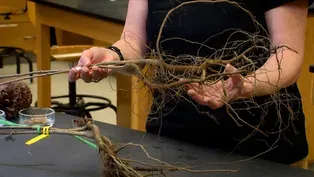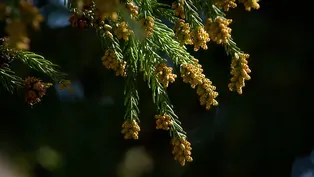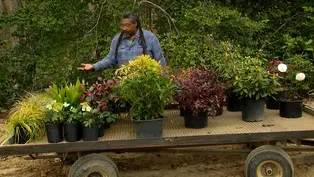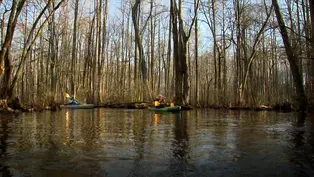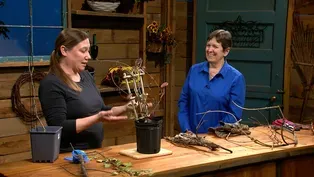Virginia Home Grown
The Life Inside of Trees
Clip: Season 25 Episode 1 | 6m 42sVideo has Closed Captions
Learn about the many types of life recently discovered inside of trees
Dr. Glynn Percival from Bartlett Tree Experts joins Peggy Singlemann in the studio to discuss his research into the microbial life inside of trees. Featured on VHG episode 2501, March 2025.
Problems with Closed Captions? Closed Captioning Feedback
Problems with Closed Captions? Closed Captioning Feedback
Virginia Home Grown is a local public television program presented by VPM
Virginia Home Grown
The Life Inside of Trees
Clip: Season 25 Episode 1 | 6m 42sVideo has Closed Captions
Dr. Glynn Percival from Bartlett Tree Experts joins Peggy Singlemann in the studio to discuss his research into the microbial life inside of trees. Featured on VHG episode 2501, March 2025.
Problems with Closed Captions? Closed Captioning Feedback
How to Watch Virginia Home Grown
Virginia Home Grown is available to stream on pbs.org and the free PBS App, available on iPhone, Apple TV, Android TV, Android smartphones, Amazon Fire TV, Amazon Fire Tablet, Roku, Samsung Smart TV, and Vizio.
Providing Support for PBS.org
Learn Moreabout PBS online sponsorshipWell, Glynn, I've not really had many guests who brought Petri dishes and tree cookies and dirt, so this is gonna be interesting.
So, wow.
I mean, I took care of beautiful, majestic trees my whole career and I always wondered, why are they bigger than the others?
>>Okay, well, thanks for inviting me.
It's a real pleasure to be here and it's great to kind of talk about some of the research I was doing in the United Kingdom.
And we have a lot of big old trees in the UK.
>>Yes, you do.
>>And what we tend to find is really one of the major obstacles, as it were, can be like diseases.
So, for example, elms are big trees, but if you get Dutch elm disease, you've got a lot of problems.
In the UK, we have a disease called acute oak decline, which is killing a lot of our oak trees.
>>Wow, yeah.
>>And we decided to do some research and try and work out if there was maybe a very different solution to managing this disease.
And what we did find was that some trees were very heavily infected and had lots of bleeds, bleeding cankers, and other oak trees at the side of it were showing no symptoms at all.
So, for example, what not many people realize is when you actually look inside a tree, they think it's sterile.
They think there's absolutely nothing living within the tree.
>>Just a bunch of wood.
>>But in reality, I mean, trees are absolutely rammed full of bacteria and fungi, which don't do the tree any harm whatsoever.
>>Interesting.
>>And we call them endophytes, as in endo within and phytes within the plant.
And what we decided to do was, when we actually had these diseased trees, was we wanted to look at was the endophytes living within a diseased tree different from a non-diseased tree?
And I just wanted to show you just what I mean by this.
>>That's amazing.
>>Where we can literally, I mean, this is just some, very few, of those thousands of different types of living organisms.
>>Absolutely amazing.
>>And then one of the great things about research is you suddenly find a result which is absolutely incredible.
And one of the fungi we actually identified which were present within the non-diseased trees was it was penicillin.
>>Oh my golly (chuckles).
>>I mean, Sir Alexander Fleming, penicillin antibiotics.
And we actually found that the non-diseased oaks had, we identified six different species of penicillin and two we couldn't even identify.
>>Oh, wow.
>>And if we actually look at the top here, this looks like one of the species of penicillin.
And then what we also then decided to do was we took all these good endophytes, as it were, and we had a diseased tree and we literally infused them into the diseased tree and the diseased tree started to heal.
>>Oh, that's fantastic.
>>And we just suddenly thought, "Wow, you know, this is great."
You know, this potentially opens up, and we see this time and time again where we have a population of trees, same species, some are heavily diseased and some have very little disease.
And we're now learning more just about the incredible important role these endophytes play in longevity, in, like, some trees can, species, will do well on soils contaminated with heavy metals and the endophytes have been shown to play a crucial part in their survival.
And it's something we never think about.
>>No.
>>We just think trees, perfectly sterile.
>>Right.
And we think if the tree has a problem, that it has to be something either abiotic or biotic.
Meaning is this a fungus?
Is there disease?
You know, is there insects?
We don't think about the makeup of the tree itself.
But what does the role of soil play in all of this?
>>Well, you see, that's the other, there's two major factors that kind of really influence longevity and one is what we've just spoke about, is obviously preventing the disease ingress, is really soil.
90% of all tree problems we see above ground are caused by problems below ground.
Now, as you can see, this is a nice, healthy- >>Yeah, that's gorgeous.
>>Soil I took from one of our forests close by.
Lots and lots, plenty of root growth.
Now, that's great in the forest environment, but we like to grow our trees in urban landscapes, our towns, cities, car parks.
Sadly, it's a very different type of soil.
And with all due respect, I mean, trees would find it incredibly difficult to live that longevity growing in soils like this.
It's very cloddy.
It gets compacted, dries out, et cetera, >>Et cetera.
>>So we like to do a lot of work at remediating the soil.
>>Yes.
>>And one of the things we try to do is even though we have these urban soils, you know, we'll apply these different types of- >>Mulches.
>>Mulches.
And this is a very common one, whoops, which is used, which is the- >>Pine tags.
Pine needles.
>>The pine needles.
>>Yes.
>>Now, personally, I don't think this is really a very good one.
I think they are better ones.
And what I would actually more recommend if you are to apply the woodchip mulch is use maybe something more that has, like you can see here, like more the leaves.
And the advantage of if you apply a woodchip mulch high in leaves, it degrades quicker, you get the benefits quicker, but you'll have to replace it, in essence, after a year.
>>Quickly.
Yes.
So?
>>So you can use one that, again, which is really more just heavily- >>It's more woody >>As you can see, it's more woody.
It has the same benefits.
It just takes a little bit longer.
But it lasts longer.
You maybe need to replace it every two years.
And really to me, applying a woodchip mulch is really a fundamental factor in achieving longevity because in urban landscapes, we have a very bad habit of raking up all the leaves and leaves obviously in a woodland environment rot back down.
So we can counteract that by using these woodchip mulches.
>>Well, Glynn, this is fascinating.
It's fascinating to learn about penicillin within the tree and it's also fascinating to, I'll say, reemphasize the importance of mulch, and not just any mulch, but mulch with leaves.
So I thank you so much.
>>Yeah.
>>Yes.
Video has Closed Captions
Learn the correct root to shoot ratio for planting new trees (3m 17s)
Video has Closed Captions
Learn how champion trees are measured and the special care they receive (8m 11s)
Video has Closed Captions
Explore shrubs and groundcovers that grow well under big trees (3m 11s)
Video has Closed Captions
Explore the Dragon Run watershed, one of Virginia’s most pristine natural sites (8m 4s)
Video has Closed Captions
Learn the differences in native and invasive vines (5m 20s)
Providing Support for PBS.org
Learn Moreabout PBS online sponsorshipVirginia Home Grown is a local public television program presented by VPM
